Product organizations are complex, with a multitude of teams and roles that need to work in unison to deliver successful products. Yet, many product teams face similar challenges that hinder their ability to operate effectively and deliver outcomes. These challenges persist despite the availability of specialized tools. This is because product teams are part of a bigger picture and require an integrated approach and the right product portfolio management to manage these complexities effectively so they can deliver more outcomes, faster.
Where Do Traditional Tools Fail?
With all the tools available today, shouldn’t these challenges be a thing of the past? After all, product managers have access to specialized roadmap tools, and engineering teams are equipped with resources tailored to their needs. So, why do these challenges still persist?
The reality is, product teams are part of a bigger picture. They don’t operate in isolation. In fact, 92% of product teams depend on other teams. And so while it may not be a lack of tools, a mix of disconnected tools and processes, leads to conflicts and misalignments.
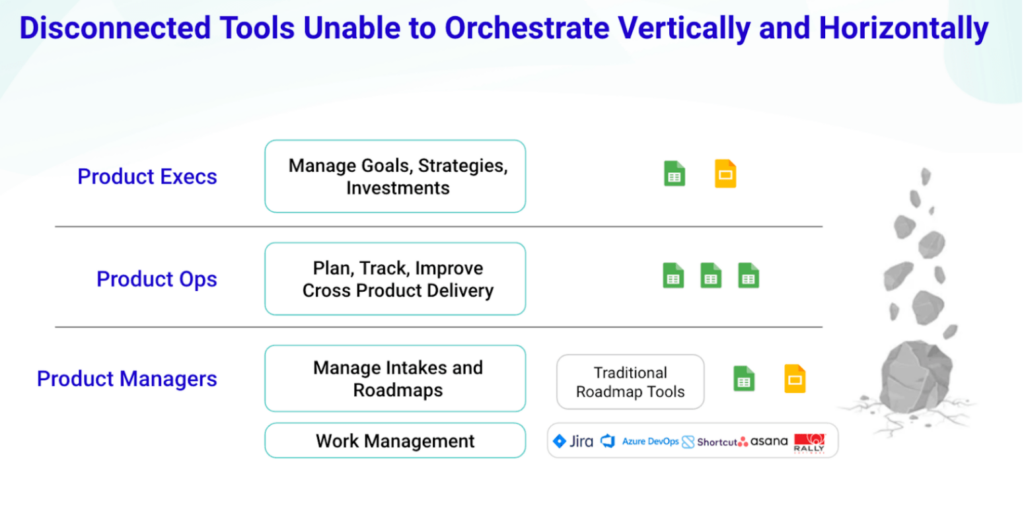
What Are The Needs Of An Outcome Focused Product Organization?
Product organizations consist of diverse roles and responsibilities, each integral to the success of a product’s lifecycle and to achieving outcomes. Let’s dive into the specific needs of these key players and challenges that stem from a lack of an integrated product portfolio management system:
- Product Executives: Responsible for setting and communicating the vision and strategic direction as well as any changes to ensure continual alignment. Without clear communication and connection of strategy through execution, there’s a risk of misalignment within teams that hinders the overall progress of the organization.
- Product Managers: Responsible for leveraging strategic intent and customer insights to build roadmaps while fostering stakeholder communication. Product managers often find themselves at crossroads due to their dependencies from other teams. This reliance can lead to roadmap conflicts and misalignments with the broader organizational strategy.
- Product Operations: Act as the linchpin between various teams, and are responsible for coordinating, planning, and communication. Their role is to facilitate a smooth flow of information and ensure that all teams are in sync. Unfortunately, the absence of a unified system to manage these connections often leaves product operations struggling to bridge the gap between teams and processes.
The common theme running through these challenges is the need for a holistic approach that can tie together the disparate elements of a product organization. That’s where a Product Portfolio Management System comes into play.
How Does Portfolio Management Address the Complex Needs of Product Teams?
The unique challenges of product management are complex and multi-faceted and call for solutions that go beyond traditional product management and tools and address the needs of the entire portfolio and organization.
Effective product portfolio management considers several key aspects:
- Strategic Goal Setting by Leadership: It begins with product leaders and executives who must define clear objectives and a strategic direction for the product line, ensuring that every initiative contributes to the overall vision of the company.
- Integration of Customer and Stakeholder Feedback: Product managers translate customer feedback and stakeholder insights into actionable product roadmaps that meet market demands while aligning with strategic goals.
- Synchronization Across Teams: Product Operations is tasked with the coordination and alignment of various teams to account for cross-team dependencies.
- Proactive Risk Management: A portfolio management approach provides the ability to identify potential risks early and employ strategies to address them.
- Outcome-Driven Delivery: The ultimate aim is to deliver products that not only reach the market but also achieve the desired outcomes, fulfilling both customer expectations and business objectives.
What Should Product Organizations Look For When Choosing A Tool?
Information flow within product teams is complex, often leading to challenges for many product organizations. This spans across various levels – from individual product managers to cross-functional teams and extends up to executive leadership – necessitating a seamless connection. An effective Product Portfolio Management System connects the moving pieces of how a product organization operates and who needs to be involved.
An Effective Product Portfolio Management Platform Should:
- Enable executives and product leaders to set goals, strategies, and allocations and communicate strategic intent and vision to the rest of the team
- Provide each member product organization with comprehensive insights into progress and performance
- Equip product managers to build product roadmaps that sync to engineering workflows
- Allow for the defining, roll out, and improvement of product development processes for successful portfolio delivery
- Facilitate responsive planning, allowing for the orchestration of cross-team dependencies to create an achievable plan
How Dragonboat Helps
- Shifting To An Outcome-Focused Mindset: Dragonboat helps set clear strategic goals aligned with your organization’s vision, ensuring that every initiative is outcome-focused.
- Prioritizing Based On Outcomes: With Dragonboat, you can use data to prioritize initiatives based on their potential revenue impact and strategic alignment.
- A Single Source Of Truth For Your Portfolio: Dragonboat provides a unified platform to manage your product portfolio, eliminating the need for disjointed tools like Excel or PowerPoint.
- Aligning Backlogs To Objectives: Dragonboat allows for strategic roadmap development, aligning product plans with broader organizational goals.
Where Should Product Organizations Start?
So you have the right tool in place, what’s next? The key to success lies in tackling the most pressing issues first. This begins by identifying the core challenges, whether they be executive decision-making, cross-team collaboration, or the intricacies of product delivery. Take a look below to see how Dragonboat enables you to solve three of the top challenges faced by product teams.
Struggle with allocation & prioritization? → Allocate & Prioritize The Right Things
Struggle to deliver? → Deliver on Cross-Team Roadmap Commitments
Struggle in responding to business changes? → Adjust Responsively Based on impact
Even resolving a single issue can significantly propel a team towards its goals, and sets a path towards continuous improvement and faster outcomes.
How Does Dragonboat Enable You To Allocate & Prioritize The Right Things?
Deciding what to build next is a critical question for any product team aiming to deliver impactful outcomes. But how can teams effectively allocate resources and prioritize these elements to ensure strategic alignment and optimal results? Dragonboat introduces a streamlined approach to conquer this complexity.
1 – Setting Strategic Goals & Optimizing Resource Allocation
Use Dragonboat to define your overarching goals and strategies, helping teams prioritize initiatives that align with company objectives. Then, align your resources with your objectives, leveraging Dragonboat to ensure your investments are made strategically.
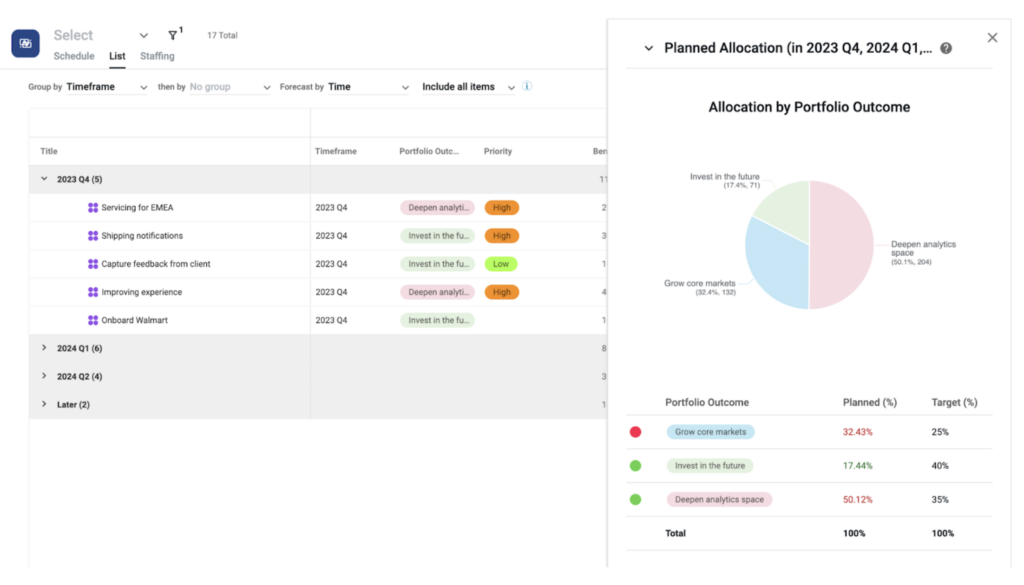
2 – Streamline With Insight-Driven Prioritization
- View goals & strategies in a single pane: Dragonboat enables you to consolidate goals, initiatives, and features into a single, easy-to-navigate view, simplifying the prioritization process.

- Utilize Data to Make Smarter Product Decisions: Dragonboat doesn’t just track requests and ideas; it quantifies their revenue impact, adjusting as customer dynamics evolve, so you can make decisions based on real value.

- Align product plans to prevent conflicts: Develop strategic roadmaps in Dragonboat that resonate with your portfolio goals, allowing product managers to align their priorities and navigate dependencies with ease.
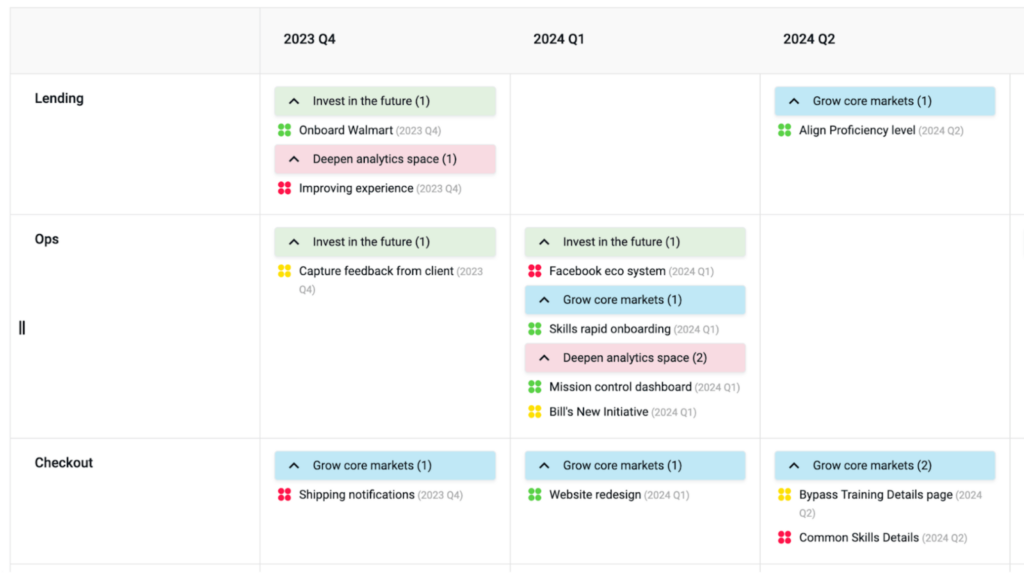
3 – Track allocations to enhance visibility
- Stay on Budget: Agile methods can complicate tracking of resources as project scopes evolve. Dragonboat’s Allocation Report cuts through the complexity by offering a real-time comparison of your planned and reported allocation helping you avoid unintentional investment waste.
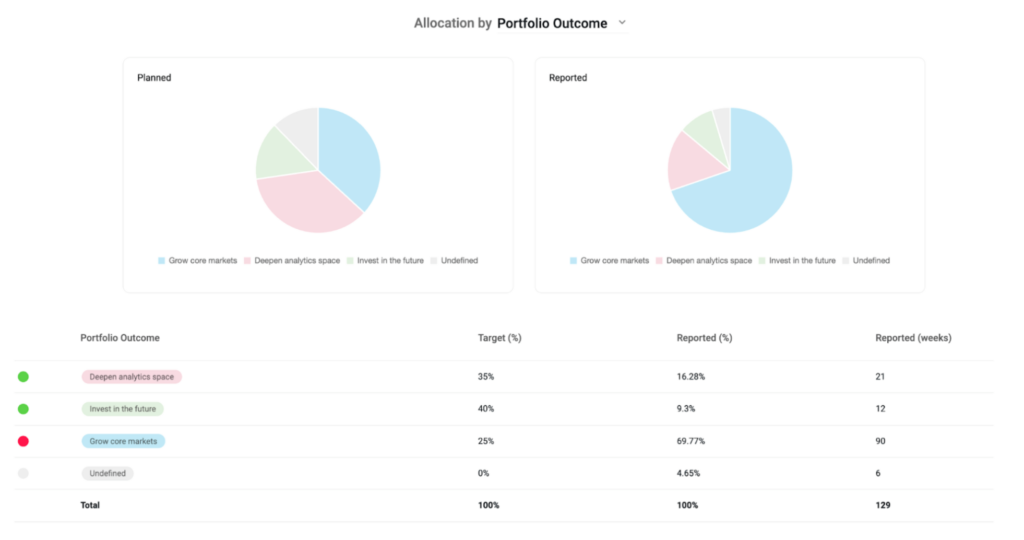
- Empower Stakeholders with Comprehensive Roadmap Insights: Dragonboat provides a snapshot comparison of outcomes and roadmaps, making it simple to share updates with stakeholders. This ensures everyone involved can help guide necessary adjustments to make the best investment decisions.

How Do You Deliver Cross-Team Roadmap Commitments With Dragonboat?
Delivering on roadmap commitments, particularly across multiple teams, remains a common challenge for product organizations. But what if there was a structured way to navigate this complexity? Dragonboat offers a solution that breaks down the process into manageable steps.
1 – Gain Insights & Control Over Delivery
- Automated Delivery Health Monitoring: Utilize Dragonboat to automatically gather delivery insights from engineering tools. This ensures your release schedules are maintained and delivery commitments are met through comprehensive health checks and real-time monitoring of progress.
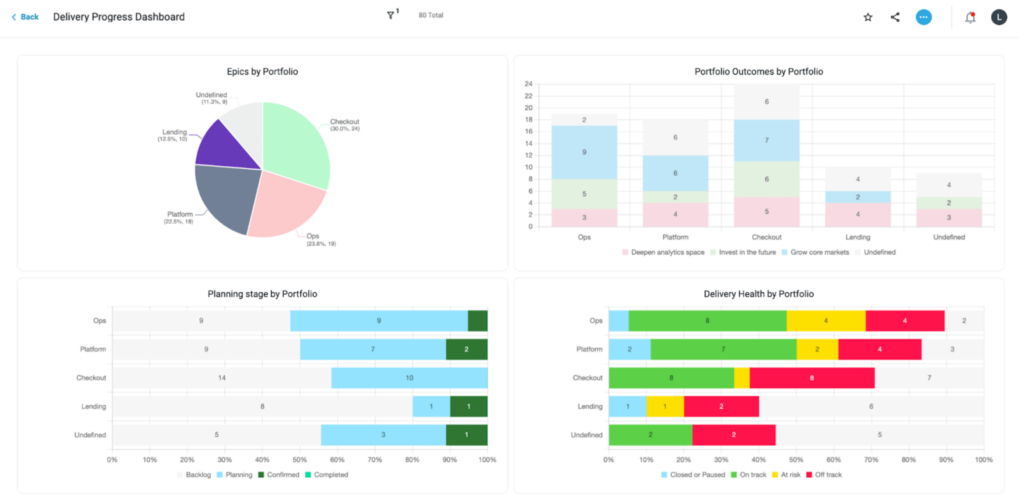
- Risk Management: Avoid the pitfalls of scope creep and delays with Dragonboat’s automatic risk monitoring. By comparing actual progress to planned scopes, teams can spot and mitigate risks early.
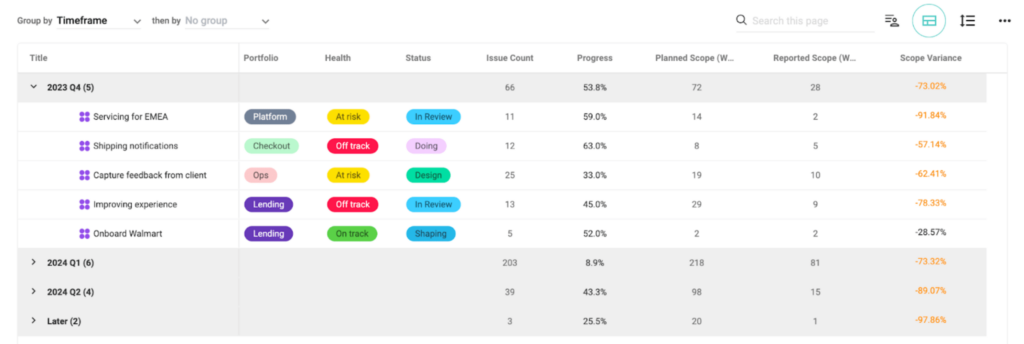
- Trend Analysis: Understanding the movement of your portfolio is key in agile environments. Dragonboat’s trend analysis tools help forecast and adapt to changes, ensuring you stay on track.

2 – Streamline Your PDLC and Facilitate Communication
- End-to-End PDLC Monitoring: Define and refine your PDLC with Dragonboat, aligning your product development with strategic goals and operational cadence.

- Engage Stakeholders with Custom Reports: Create tailored, evergreen reports with Dragonboat to keep stakeholders informed and engaged, facilitating better decision-making and alignment.
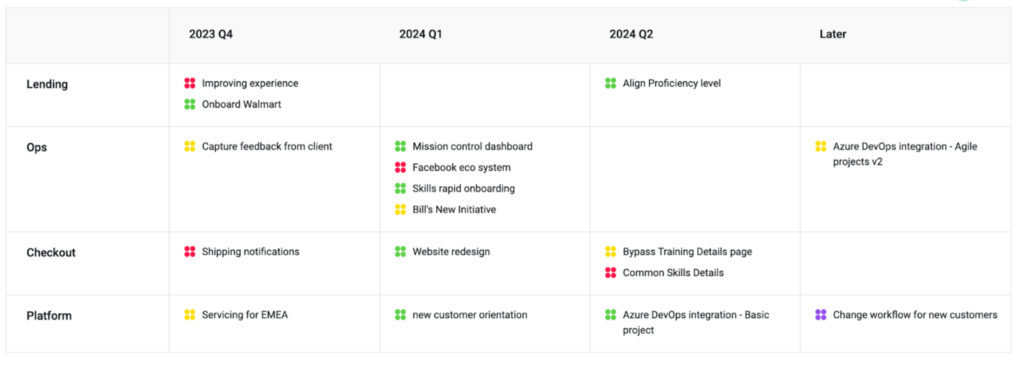
3 – Create an achievable plan
- Resource and Dependency Planning: Build realistic roadmaps with Dragonboat, considering your resources and cross-team dependencies, to avoid overpromising and under delivering.
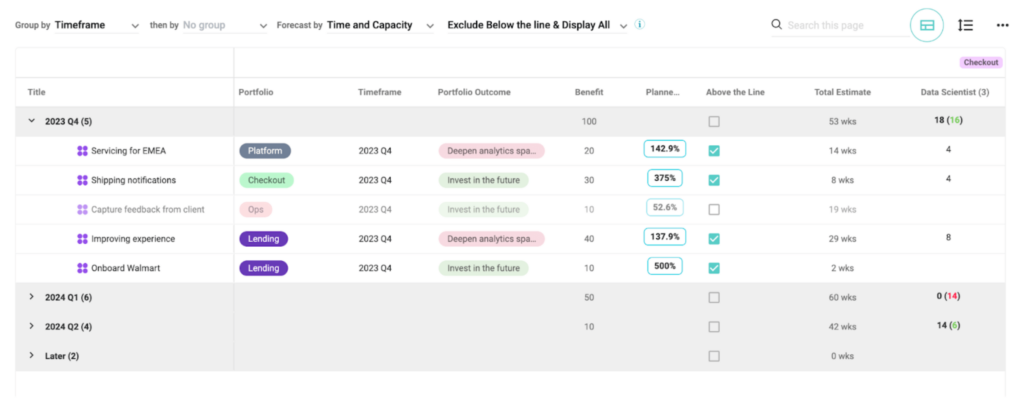
How Does Dragonboat Enable You To Adjust Responsively Based On Impact?
The ability to respond and adapt quickly is key to accelerating outcomes. Product teams must have a pulse on performance and the agility to pivot based on real-world impacts. Dragonboat equips teams with the capabilities to monitor, measure, and modify their strategies responsively, ensuring that they can act swiftly and effectively in the face of change.
1 – Enhancing Product Strategy with Outcome and Resource Monitoring
- Track Real-Time Progress: Tracking progress towards designed outcomes is essential for any organization looking to achieve its goals. Metrics provide a way to measure progress and can be associated with any level of Objectives and Key Results (OKRs) in Dragonboat.

- Automated Delivery Oversight: Gain insights into your delivery progress with Dragonboat’s Portfolio Delivery Dashboard, which integrates directly with your engineering tools to offer a clear picture of your delivery health over time.
- Optimize Resource Allocation: Dragonboat’s Allocation Report allows for a side-by-side comparison of your planned and actual spending, giving you the foresight to adjust your allocations and plan more effectively for the future.
2 – Linking Product Metrics to Outcomes for Strategic Success
- Integrate outcomes with outputs: With Dragonboat, connect relevant metrics to each portfolio item to gauge the real-world impact of your features or initiatives post-launch.
- Utilize metrics to measure impact: Outcome tracking using metrics allows you to measure progress towards your goals and make data-driven decisions. By using metrics to track outcomes, you can identify areas that need attention and adjust your approach as needed to achieve your desired results.

3 – Strategically Allocating Resources and Evaluating Portfolio Scenarios
- Adapt Allocation to Drive Desired Outcomes: Use Dragonboat’s detailed allocation reports to shift resources in real time, ensuring they align with your strategic outcomes.
- Plan with Flexibility Using ‘What If’ Scenarios: Dragonboat enables you to explore multiple portfolio roadmaps and ‘what if’ scenarios. This feature allows you to anticipate outcomes without disrupting current plans, providing a solid basis for making informed product investment decisions.
The essence of effective product management is not just in the creation but in the orchestration of all elements involved. From setting strategic goals to adapting to market feedback, from aligning cross-functional teams to proactive risk management. It’s not just about managing products; it’s about managing outcomes—a mission Dragonboat is committed to guiding you through from start to finish.
As we’ve outlined, whether it’s through streamlining PDLC, enhancing stakeholder communication, or dynamically adjusting to the market, Dragonboat stands ready to turn your product challenges into opportunities to accelerate outcomes. Book a time to meet with us today.



